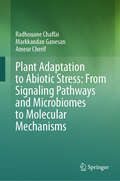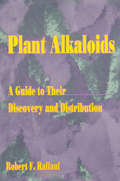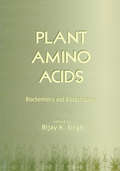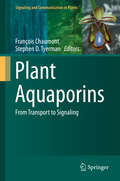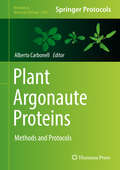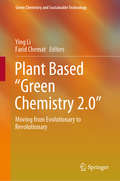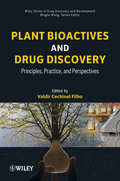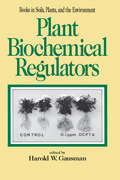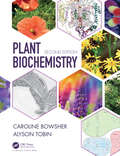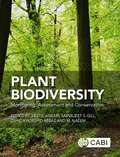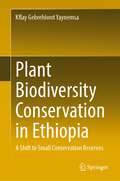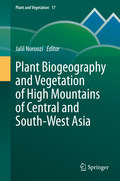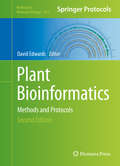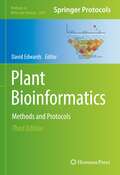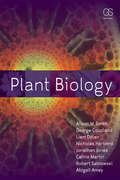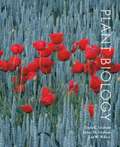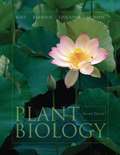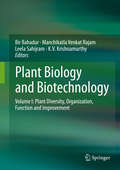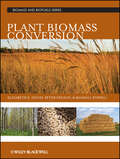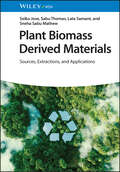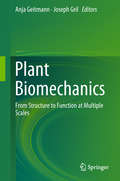- Table View
- List View
Plant Adaptation to Abiotic Stress: From Signaling Pathways and Microbiomes to Molecular Mechanisms
by Radhouane Chaffai Markkandan Ganesan Ameur CherifThe book “Plant Adaptation to Abiotic Stress: From Signaling Pathways and Microbiomes to Molecular Mechanisms” comprehensively examines abiotic stressors—cold, heat, light, salinity, and water scarcity—across its 18 chapters. Focusing particularly on Arabidopsis thaliana, it investigates abiotic stresses, adaptation strategies, and molecular pathways. Furthermore, it addresses broader issues, including climate challenges, food security, water scarcity, and agricultural concerns such as soil acidity and aluminum stress. It proposes adaptive measures for cultivating stress-resistant crops and sheds light on genetic modification methods such as CRISPR-Cas9, integrating nanotechnology in plant breeding. Emphasizing transcription factors, post-translational protein modifications, and diverse noncoding RNAs (long noncoding RNAs, circular RNAs, microRNAs, and small interfering RNAs), the book highlights their role in regulating gene expression during stress responses. It specifically underscores secondary messengers, plant hormones, and MAPK cascades within intracellular signaling pathways. Additionally, it discusses the roles of endophytic bacteria and microbial interactions in bolstering stress resilience. The book explores state-of-the-art research methodologies in plant breeding, omics approaches, and nanotechnology integration for developing stress-resistant crop varieties, advocating for agricultural sustainability. Tailored for plant physiology scientists, academics, and postgraduate students, it amalgamates diverse research findings, serving as a pivotal resource to comprehend intricate plant responses to environmental challenges.
Plant Alkaloids: A Guide to Their Discovery and Distribution
by Lyle E CrakerPlant Alkaloids: A Guide to Their Discovery and Distribution serves as a record of both the positive and negative results obtained in the screening of more than 20,000 plant species for alkaloids in a forty-year search for new medicinal agents and other pharmacological substances. Designed to increase general knowledge of the Plant Kingdom, this book equips present and future generations of phytochemists with the skills and knowledge necessary for developing new alkaloid compounds. Recording the results of screening tests from approximately 400 genera of plants found primarily in zones beneath 45? N Latitude, Plant Alkaloids contributes to the efforts to calculate and safeguard the resources of the rainforests of the world. By offering results `from the field,'Plant Alkaloids surpasses the tradition of books on alkaloid chemistry that only emphasize the chemical and physical properties of known compounds, their established structures, biogenetic origins, taxonomic usefulness, and pharmacological actions. These results, in many cases, constitute the first record of the probable presence of alkaloids in the species under study. By documenting both positive and negative results, Plant Alkaloids directs the search for potentially new and useful compounds, while alleviating much of the time and expense of screening plants where results have already been obtained.An invaluable reference book for scientists in any of the life sciences, Plant Alkaloids provides a general index containing references to standard works on alkaloid chemistry and the subject?s vast literature. In addition to offering a description of the size of each plant family and its economic importance, this book also lists the genera and species of each plant tested according to accepted taxonomic names and notes disagreement over taxonomic assignment where it exists.
Plant Amino Acids: Biochemistry and Biotechnology (Books in Soils, Plants, and the Environment)
by Bijay K. SinghCovers the basic knowledge of the regulation of biosynthesis of various amino acids in plants and the application of this knowledge to the discovery of novel inhibitors of amino acid biosynthesis and for enhancing the nutritional value of plant products. Provides an exhaustive list of pathway inhibitors.
Plant Antioxidants and Health (Reference Series in Phytochemistry)
by Kishan Gopal Ramawat Halina Maria Ekiert Jaya AroraThis book provides a comprehensive reference guide to plant-derived antioxidants, their beneficial effects, mechanisms of action, and role in disease prevention and improving general health (anti-ageing effect). The content is divided into three main parts, the first of which covers various antioxidants (such as polyphenols, carotenoids, tocopherols, tocotrienols, glutathione, ascorbic acid), their origins, plant biochemistry and industrial utilization. In turn, the book’s second, main part focuses on antioxidants’ beneficial health effects, explains biochemical fundamentals such as the free radical theory and oxidative stress, and discusses antioxidants’ role in e.g. cancer, cardiovascular diseases, inflammation, degenerative diseases and ageing. The third part reviews general laboratory methods for antioxidant screening, preservation and determination. Written by an international team of experts, this highly interdisciplinary book will benefit a broad range of health professionals and researchers working in biochemistry, biotechnology, nutrition, plant science and food chemistry. It offers an indispensable, up-to-date guide for anyone interested in antioxidants and the role of a plant-based diet in disease prevention and control
Plant Aquaporins
by François Chaumont Stephen D. TyermanAquaporins are channel proteins that facilitate the diffusion of water and small uncharged solutes across cellular membranes. Plant aquaporins form a large family of highly divergent proteins that are involved in many different physiological processes. This book will summarize the recent advances regarding plant aquaporins, their phylogeny, structure, substrate specificity, mechanisms of regulation and roles in various important physiological processes related to the control of water flow and small solute distribution at the cell, tissue and plant levels in ever-changing environment.
Plant Argonaute Proteins
by Alberto CarbonellThis volume provides the reader with step-by-step methods to study plant ARGONAUTE (AGO) functions. Chapters in Plant Argonaute Poteins: Methods and Protocols summarize the main biochemical, molecular and cytological methods to study AGO-small RNA complexes and their interactions with target RNAs, AGO subcellular localization, AGO association with polysomes, AGO role in meiosis and DNA repair, methods for the identification, cloning and characterization of AGO genes in different plant species, and non-radioactive protocols for small RNA detection. Finally, a series of chapters describing computational methods to study plant AGO function and evolution are provided. Written in the highly successful Methods in Molecular Biology series format, chapters include introductions to their respective topics, lists of the necessary materials and reagents, step-by-step, readily reproducible laboratory protocols, and tips on troubleshooting and avoiding known pitfalls. Authoritative and practical, Plant Argonaute Proteins: Methods and Protocols aims to deliver the most complete and updated list of protocols to study plant AGO function.
Plant Based “Green Chemistry 2.0”: Moving from Evolutionary to Revolutionary (Green Chemistry and Sustainable Technology)
by Farid Chemat Ying LiThis book provides practical information on obtaining and using a wide variety of plant based reagents for different sectors, addressing the needs and challenges in a single resource. The chapters complement each other seamlessly and present contributions from reputed international researchers and renowned professionals from industry, covering the latest efforts in the field. The book serves as the starting point for future collaborations in the new area “Plant Based Green Chemistry” between research, industry, and education, covering large ecologic and economic applications: perfume, cosmetic, pharmaceutical, food ingredients, nutraceuticals, biofuels, or fine chemicals industries. This book is aimed at professionals from industries, academicians engaged in plant based green chemistry, researchers and graduate level students, but will also be useful to food technologists and students and researchers involved in natural products chemistry.
Plant Bioactives and Drug Discovery
by Valdir Cechinel-FilhoAn in-depth exploration of the applications of plant bioactive metabolites in drug research and development Highlighting the complexity and applications of plant bioactive metabolites in organic and medicinal chemistry, Plant Bioactives and Drug Discovery: Principles, Practice, and Perspectives provides an in-depth overview of the ways in which plants can inform drug research and development. An edited volume featuring multidisciplinary international contributions from acclaimed scientists researching bioactive natural products, the book provides an incisive overview of one of the most important topics in pharmaceutical studies today. With coverage of strategic methods of natural compound isolation, structural manipulation, natural products in clinical trials, quality control, and more, and featuring case studies on medicinal plants, the book serves as a definitive guide to the field of plant biodiversity as it relates to medicine. In addition, chapters on using natural products as drugs that target specific disease areas, including neurological disorders, inflammation, infectious diseases, and cancer, illustrate the myriad possibilities for therapeutic applications. Wide ranging and comprehensive, Plant Bioactives and Drug Discovery also includes important information on marketing, regulations, intellectual property rights, and academic-industry collaboration as they relate to plant-based drug research, making it an essential resource for advanced students and academic and industry professionals working in biochemical, pharmaceutical, and related fields.
Plant Biochemical Regulators
by Harold W. GausmanA textbook for a graduate or advanced undergraduate course in biotechnology in a wide range of fields concerned with plants. Describes the use of both endogenous and introduced biochemical regulators to manipulate plant responses. Annotation copyright Book News, Inc. Portland, Or.
Plant Biochemistry
by Caroline Bowsher Martin Steer Alyson TobinPlant Biochemistry presents each topic from the cellular level to the ecological and environmental levels, placing it in the context of the whole plant. Biochemical pathways are represented as route maps, showing how one reaction follows another. These maps emphasize the dynamism and fl exibility of the plant in the face of environmental challenges. The unique and wide-ranging approach of this book emphasizes the importance of teaching and learning pathways within the framework of what the pathway does and why it is needed. Plant Biochemistry is invaluable to undergraduate students who wish to gain insight into the relevance of plant biochemistry to humans and animals. It is an ideal reference text for graduates and researchers.
Plant Biochemistry
by Caroline Bowsher Alyson TobinPlant Biochemistry focuses on the molecular and cellular aspects of each major metabolic pathway and sets these within the context of the whole plant. Using examples from biomedical, environmental, industrial and agricultural applications, it shows how a fundamental understanding of plant biochemistry can be used to address real-world issues. It illustrates how plants impact human activity and success, in terms of their importance as a food supply and as raw materials for industrial and pharmaceutical products, and considers how humans can benefit from exploiting plant biochemical pathways. All chapters in this second edition have been substantially revised to incorporate the latest research developments, and case studies include updates on progress in developing novel plants and plant products. The artwork, now in full color, superbly illustrates the key concepts and mechanisms presented throughout. Key features: Presents each topic from the cellular level to the ecological and environmental levels, placing it in the context of the whole plant. Biochemical pathways are represented as route maps, showing how one reaction interacts with another both within and across pathways. Includes comprehensive reading lists with descriptive notes to enable students to conduct their own research into topics they wish to explore further The wide-ranging approach of this book emphasizes the importance of teaching and learning plant biochemical pathways within the framework of what the pathway does and why it is needed. Illustrates the fundamental significance of plants, in terms of their importance as a food supply, as raw materials and as sources of novel products. Plant Biochemistry is invaluable to undergraduate students who wish to gain insight into the relevance of plant metabolism in relation to current research questions and world challenges. It should also prove to be a suitable reference text for graduates and researchers who are new to the topic or who wish to broaden their understanding of the range of biochemical pathways in plants.
Plant Biodiversity
by Sarvajeet S. Gill M. Naeem Abid A. Ansari Zahid Khorshid AbbasConservation biologists use the results of regular monitoring of the species diversity and structure of plant communities to help understand the impacts of perturbations caused by humans and other environmental factors on ecosystems worldwide. Changes in plant communities can, for example, be a reflection of increased levels of pollution, a response to long-term climate change, or the result of shifts in land-use practices by the human population. This book presents a series of essays on the application of plant biodiversity monitoring and assessment to help prevent species extinction and ecosystem collapse and to solve problems in biodiversity conservation. Written by a large, international team of researchers, Plant Biodiversity uses case studies and examples from all over the world and from a broad range of terrestrial and aquatic ecosystems. The book is aimed at any graduate students and researchers with a strong interest in plant biodiversity monitoring and assessment, plant community ecology, biodiversity conservation, and the environmental impacts of human activities on ecosystems.
Plant Biodiversity Conservation in Ethiopia: A Shift to Small Conservation Reserves
by Kflay Gebrehiwot YaynemsaThis book covers biodiversity conservation under special consideration of the challenges in the global south with particular attention being paid to consider the existing conservation challenges in relation to the study area in Ethiopia. Key issues are addressed, such as the current and future threats to plant biodiversity in Ethiopia, as well as the single large or several small conservation approaches and which approach is feasible for Ethiopia. Furthermore, an innovative approach was developed that enhances ecological connectivity and promotes ecological restoration through community involvement. The book also covers why a systematic conservation planning approach is important and should be used in new protected area establishments, and also looks at the trends of plant ecology research over the past five decades, revealing research gaps and suggesting future research topics. Despite its focus on Ethiopian plant diversity, abundant examples were used from different continents making this book attractive to global readers. It will be of interest for policy- and decision-makers in the conservation sector, researchers interested in biodiversity, climate change, conservation and sustainable use of natural resources, and would be a valuable resource for university students.
Plant Biogeography and Vegetation of High Mountains of Central and South-West Asia (Plant and Vegetation #17)
by Jalil NorooziThis book presents an overview study about plant biogeography and vegetation of the high mountains of Central and South-West Asia, by a group of specialists familiar with its area and plant growth and ecology. This book discusses its ecological and evolutionary drivers and also its conservation priorities.Central and South-West Asia is one of the most diverse areas in the northern hemisphere and several biodiversity hotspots are concentrated in this region. Most of the biodiversity hotspots are associated with high mountain ranges of the region. Moreover, these mountains have been immigration corridors for the Central Asian flora to reach Euro-Siberian and Mediterranean regions. Despite its importance, there is no overview publication to present the plant biogeography and vegetation of these mountains and most of the publications are local or rather imprecise
Plant Bioinformatics
by David EdwardsThis book aims to assist research scientists in choosing the most applicable database or bioinformatics tools to aid and promote their research in plant biotechnology. Chapters include practical examples and highlight common problems encountered in bioinformatics analysis. Further chapters are aimed at researchers developing bioinformatics databases and tools, detailing commonly applied database formats and biology-focused scripting languages.
Plant Bioinformatics: Methods and Protocols (Methods in Molecular Biology #2443)
by David EdwardsThis new edition focuses on applied bioinformatics with specific applications to crops, model and diverse plant species. The scope extends from the genome to the phenome and includes aspects of data management, analysis, visualization, and integration. The methods and approaches found within reflect the increasing use of high performance computing infrastructure to analyze and manage the enormous volume of data being generated by the latest high throughput technologies, the establishment and further maturation of major database systems and repositories, as well as the introduction of new approaches such as machine learning. Written for the highly successful Methods in Molecular Biology series, the chapters include the kind of detailed implementation advice that leads to successful research results. Authoritative and up-to-date, Plant Bioinformatics: Methods and Protocols, Third Edition will aid researchers exploring the broad comparison of species that will drive future plant research, crop breeding, and bioinformatics developments that allow us to understand and manipulate the heritable differences between individuals and populations. Chapters 2, 3, and 26 are available open access under a Creative Commons Attribution 4.0 International License via link.springer.com.
Plant Biology
by Jonathan Jones Nicholas Harberd Alison M. Smith George Coupland Liam Dolan Cathie Martin Robert Sablowski Abigail AmeyPlant Biology is a new textbook written for upper-level undergraduate and graduate students. It is an account of modern plant science, reflecting recent advances in genetics and genomics and the excitement they have created. The book begins with a review of what is known about the origins of modern-day plants. Next, the special features of plant genomes and genetics are explored. Subsequent chapters provide information on our current understanding of plant cell biology, plant metabolism, and plant developmental biology, with the remaining three chapters outlining the interactions of plants with their environments. The final chapter discusses the relationship of plants with humans: domestication, agriculture and crop breeding. Plant Biology contains over 1,000 full color illustrations, and each chapter begins with Learning Objectives and concludes with a Summary.
Plant Biology
by Linda E. Graham Lee W. Wilcox Jim M. GrahamTo foster biological and scientific literacy, the U. of Wisconsin editors denote the central themes of evolution, ecology, and DNA science with icons. With numerous color illustrations of exceptional quality for a textbook, chapters cover introductory concepts of plants and plant-essential microbes; the molecular basis of life; plant structure, diversity, and reproduction (including genetic engineering); and plant diversity as it relates to environmental and human sustainability. Chapters include essays, review questions, and concept application exercises. Appendices include a geological timeline, answer key, and glossary.
Plant Biology (2nd Edition)
by James Graham Linda E. Graham Lee W. WilcoxThis book focuses readers on the function of plants and the role they play in our world. throughout life.
Plant Biology (2nd edition)
by C. Ralph Stocking Michael G. Barbour Terence M. Murphy Thomas L. RostProviding a comprehensive overview of the biology of plants, this biology text combines the most current, real-world examples with information on plant biodiversity and ecology, including topics like biotechnology, economic botany, and plant/human interactions.
Plant Biology and Biotechnology
by Bir Bahadur Manchikatla Venkat Rajam Leela Sahijram K. V. KrishnamurthyPlant genomics and biotechnology have recently made enormous strides, and hold the potential to benefit agriculture, the environment and various other dimensions of the human endeavor. It is no exaggeration to claim that the twenty-first century belongs to biotechnology. Knowledge generation in this field is growing at a frenetic pace, and keeping abreast of the latest advances and calls on us to double our efforts. Volume II of this two-part series addresses cutting-edge aspects of plant genomics and biotechnology. It includes 37 chapters contributed by over 70 researchers, each of which is an expert in his/her own field of research. Biotechnology has helped to solve many conundrums of plant life that had long remained a mystery to mankind. This volume opens with an exhaustive chapter on the role played by thale cress, Arabidopsis thaliana, which is believed to be the Drosophila of the plant kingdom and an invaluable model plant for understanding basic concepts in plant biology. This is followed by chapters on bioremediation, biofuels and biofertilizers through microalgal manipulation, making it a commercializable prospect; discerning finer details of biotic stress with plant-fungal interactions; and the dynamics of abiotic and biotic stresses, which also figure elsewhere in the book. Breeding crop plants for desirable traits has long been an endeavor of biotechnologists. The significance of molecular markers, marker assisted selection and techniques are covered in a dedicated chapter, as are comprehensive reviews on plant molecular biology, DNA fingerprinting techniques, genomic structure and functional genomics. A chapter dedicated to organellar genomes provides extensive information on this important aspect. Elsewhere in the book, the newly emerging area of epigenetics is presented as seen through the lens of biotechnology, showcasing the pivotal role of DNA methylation in effecting permanent and transient changes to the genome. Exclusive chapters deal with bioinformatics and systems biology. Handy tools for practical applications such as somatic embryogenesis and micropropagation are included to provide frontline information to entrepreneurs, as is a chapter on somaclonal variation. Overcoming barriers to sexual incompatibility has also long been a focus of biotechnology, and is addressed in chapters on wide hybridization and hybrid embryo rescue. Another area of accomplishing triploids through endosperm culture is included as a non-conventional breeding strategy. Secondary metabolite production through tissue cultures, which is of importance to industrial scientists, is also covered. Worldwide exchange of plant genetic material is currently an essential topic, as is conserving natural resources in situ. Chapters on in vitro conservation of extant, threatened and other valuable germplasms, gene banking and related issues are included, along with an extensive account of the biotechnology of spices - the low-volume, high-value crops. Metabolic engineering is another emerging field that provides commercial opportunities. As is well known, there is widespread concern over genetically modified crops among the public. GM crops are covered, as are genetic engineering strategies for combating biotic and abiotic stresses where no other solutions are in sight. RNAi- and micro RNA- based strategies for crop improvement have proved to offer novel alternatives to the existing non-conventional techniques, and detailed information on these aspects is also included. The book''s last five chapters are devoted to presenting the various aspects of environmental, marine, desert and rural biotechnology. The state-of-the-art coverage on a wide range of plant genomics and biotechnology topics will be of great interest to post-graduate students and researchers, including the employees of seed and biotechnology companies, and to instructors in the fields of plant genetics, breeding and biotechnology.
Plant Biomass Conversion
by Peter Nelson Elizabeth E. Hood Randall PowellA whole host of motivations are driving the development of the “renewables” industry— ranging from the desire to develop sustainable energy resources to the reduction of dangerous greenhouse gases that contribute to global warming. All energy utilized on the earth is ultimately derived from the sun through photosynthesis—the only truly renewable commodity. As concerns regarding increasing energy prices, global warming and renewable resources continue to grow, so has scientific discovery into agricultural biomass conversion. Plant Biomass Conversion addresses both the development of plant biomass and conversion technology, in addition to issues surrounding biomass conversion, such as the affect on water resources and soil sustainability. This book also offers a brief overview of the current status of the industry and examples of production plants being used in current biomass conversion efforts.
Plant Biomass Derived Materials: Sources, Extractions, and Applications
by Sabu Thomas Seiko Jose Sneha Sabu Mathew Lata SamantPlant Biomass Derived Materials Comprehensive overview of materials derived from biomass, including extraction techniques, important building blocks, and a wide range of applications Plant Biomass Derived Materials provides insights into the different sources and kinds of biomass and covers a variety of techniques to derive important building blocks from raw resources; after foundational knowledge is covered, the text continues to discuss a comprehensive list of materials and applications, ranging from nanomaterials, polymers, enzymes, dyes, and composites, to applications in energy, biomedical, water purification, aeronautics, automotive and food applications, and more. Written by four highly qualified authors with significant experience in both industry and academia, Plant Biomass Derived Materials includes information on: Biomass and its relationship to the environment, chemistry of biomass, lignin and starch, and recent trends of cashew nutshell liquid in the field Plant biomass mucilage, plant based colorants, revival of sustainable fungal based natural pigments, and algal-based natural pigments for textiles Biorefinery from plant biomass (including a case study in sugarcane straw), forest and agricultural biomass, and manufacture of monomers and precursors Chemical routes for the transformation of bio-monomers into polymers and manufacture of polymer composites from plant fibers Providing foundational knowledge on the subject and a wide array of specific applications of biomass, Plant Biomass Derived Materials is an essential resource for chemists, materials scientists, and all academics and professionals in fields that intersect with biomass: an abundant renewable resource used for many diverse purposes.
Plant Biomechanics: From Structure to Function at Multiple Scales
by Joseph Gril Anja GeitmannThis book provides important insights into the operating principles of plants by highlighting the relationship between structure and function. It describes the quantitative determination of structural and mechanical parameters, such as the material properties of a tissue, in correlation with specific features, such as the ability of the tissue to conduct water or withstand bending forces, which will allow advanced analysis in plant biomechanics. This knowledge enables researchers to understand the developmental changes that occur in plant organs over their life span and under the influence of environmental factors. The authors provide an overview of the state of the art of plant structure and function and how they relate to the mechanical behavior of the organism, such as the ability of plants to grow against the gravity vector or to withstand the forces of wind. They also show the sophisticated strategies employed by plants to effect organ movement and morphogenesis in the absence of muscles or cellular migration. As such, this book not only appeals to scientists currently working in plant sciences and biophysics, but also inspires future generations to pursue their own research in this area.
Plant Bioproducts
by Guanqun Chen Randall J. Weselake Stacy D. SingerAmong the major challenges facing society today, seeking renewable alternatives to petroleum-based fuels and manufactured goods is critically important to reducing society’s dependency on petroleum and tackling environmental issues associated with petroleum use. In recent years there has been considerable research targeted toward the development of plant-derived bioproducts to replace petrochemical feedstocks for both fuel and manufacturing. Plants not only provide a large amount of renewable biomass, but their biochemical diversity also offers many chemical and molecular tools for the production of new products through biotechnology. Plant Bioproducts is an introduction to the production and application of plant bioproducts, including biofuels, bioplastics, and biochemicals for the manufacturing sector. Contributing authors examine various bioproducts with respect to their basic chemistry, relationship to current petrochemical-based products, and strategies for their production in plants. Chapters cover the integrated roles of agronomy, plant breeding, biotechnology, and biorefining in the context of bioproduct development. Environmental, economic, ethical, and social issues surrounding bioproducts, including the use of genetically modified crops, challenges to food security, and consumer acceptance, are also covered.
